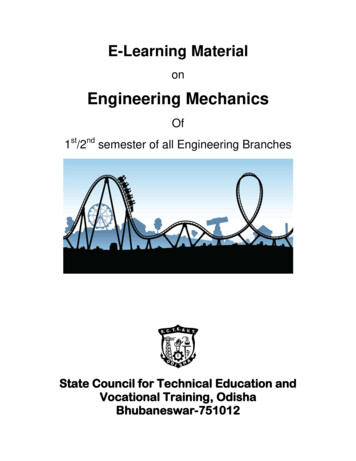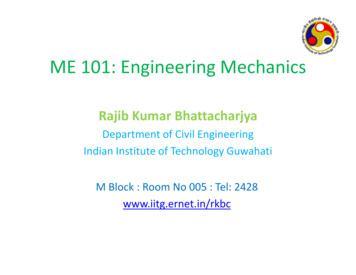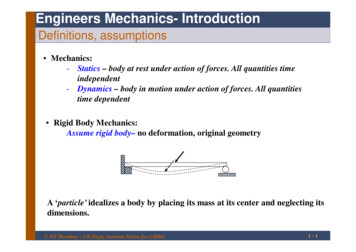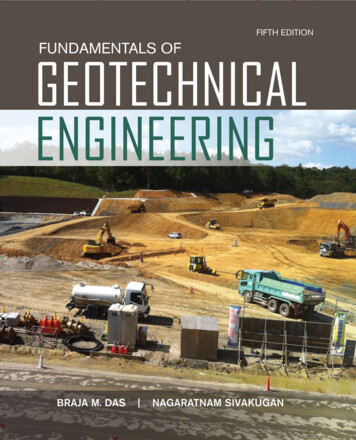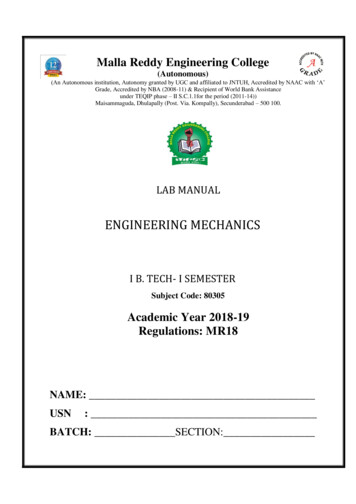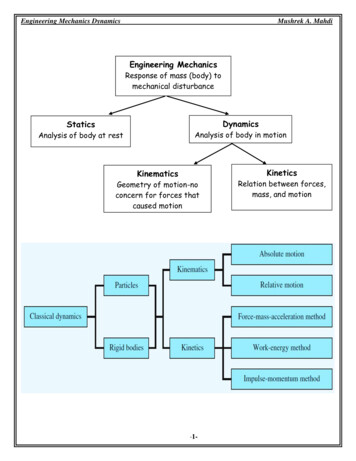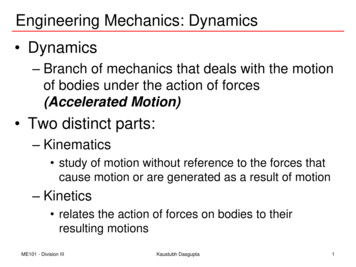
Transcription
Engineering Mechanics: Dynamics Dynamics– Branch of mechanics that deals with the motionof bodies under the action of forces(Accelerated Motion) Two distinct parts:– Kinematics study of motion without reference to the forces thatcause motion or are generated as a result of motion– Kinetics relates the action of forces on bodies to theirresulting motionsME101 - Division IIIKaustubh Dasgupta1
Engineering Mechanics: Dynamics Basis of rigid body dynamics– Newton’s 2nd law of motion A particle of mass “m” acted upon by anunbalanced force “F” experiences an acceleration“a” that has the same direction as the force and amagnitude that is directly proportional to theforce a is the resulting acceleration measured in a nonaccelerating frame of referenceME101 - Division IIIKaustubh Dasgupta2
Engineering Mechanics: Dynamics Space– Geometric region occupied by bodies Reference system– Linear or angular measurements Primary reference system or astronomical frameof reference– Imaginary set of rectangular axes fixed in space– Validity for measurements for velocity speed of light– Absolute measurements Reference frame attached to the earth? Time MassME101 - Division IIIKaustubh Dasgupta3
Engineering Mechanics: Dynamics Newton’s law of gravitationm1m2F G 2r– F :: mutual force of attraction between twoparticles– G :: universal gravitational constant 6.673x10-11 m3/(kg.s2)ME101 - Division IIIKaustubh Dasgupta4
Engineering Mechanics: Dynamics Weight– Only significant gravitational force between the earthand a particle located near the surfacemM eW G 2rW mg g GMe/r2 :: acceleration due to gravity (9.81m/s2) Variation of g with altitudeg g0R2 R h 2g is the absolute acceleration due to gravity ataltitude hg0 is the absolute acceleration due to gravity atsea levelR is the radius of the earthME101 - Division IIIKaustubh Dasgupta5
Engineering Mechanics: DynamicsEffect of Altitude on Gravitation Force of gravitational attraction of the earth on a bodydepends on the position of the body relative to the earth Assuming the earth to be a perfect homogeneoussphere, a mass of 1 kg would be attracted to the earth by aforce of: 9.825 N if the mass is on the surface of the earth 9.822 N if the mass is at an altitude of 1 km 9.523 N if the mass is at an altitude of 100 km 7.340 N if the mass is at an altitude of 1000 km 2.456 N if the mass is at an altitude of equal to themean radius of the earth, 6371 kmME101 - Division IIIKaustubh Dasgupta6
Engineering Mechanics: Dynamics Effect of earth’s rotation– g from law of gravitation Fixed set of axes at the centre of the earth– Absolute value of g Earth’s rotation– Actual acceleration of a freely falling body is less thanabsolute g– Measured from a position attached to the surface of theearthME101 - Division IIIKaustubh Dasgupta7
Engineering Mechanics: Dynamics Effect of earth’s rotationsea-levelconditions– Engineering applications :: variation of g is ignoredME101 - Division IIIKaustubh Dasgupta8
Kinematics of Particles Motion– Constrained :: confined to a specific path– Unconstrained :: not confined to a specific path Choice of coordinates– Position of P at any time t rectangular (i.e., Cartesian) coordinates x, y, z cylindrical coordinates r, θ, z spherical coordinates R, θ, Φ– Path variables Measurements along the tangent t and normal n tothe curveME101 - Division IIIKaustubh Dasgupta9
Kinematics of Particles Choice of coordinatesME101 - Division IIIKaustubh Dasgupta10
Kinematics of ParticlesRectilinear Motion Motion along a straight linet t ΔtME101 - Division IIIKaustubh Dasgupta11
Kinematics of Particles :: Rectilinear Motiont t Δt Motion along a straight linePosition at any instance of time t:: specified by its distance s measured from some convenient reference point Ofixed on the line:: (disp. is negative if the particle moves in the negative s-direction).Velocity of the particle:dsv s dtAcceleration of the particle:Both arevector quantitiesME101 - Division IIIord 2sa 2 s dt ve or –ve depending on whethervelocity is increasing or decreasing ve or –ve dependingon ve or –ve displacementvdv a dsdva v dtorKaustubh Dasguptas ds s ds12
Kinematics of ParticlesRectilinear Motion:Graphical InterpretationsUsing s-t curve, v-t & a-t curves can be plotted.Area under v-t curve during time dt vdt ds Net disp from t1 to t2 corresponding area underv-t curve st s21ds vdt2t1or s2 - s1 (area under v-t curve)Area under a-t curve during time dt adt dv Net change in vel from t1 to t2 correspondingarea under a-t curve vt v21dv adt2t1or v2 - v1 (area under a-t curve)ME101 - Division IIIKaustubh Dasgupta13
Kinematics of ParticlesRectilinear Motion:Graphical InterpretationsTwo additional graphical relations:Area under a-s curve during disp ds ads vdv Net area under a-s curve betn positioncoordinates s1 and s2 v2s2 v1vdv adss1or ½ (v22 – v12) (area under a-s curve)Slope of v-s curve at any point A dv/ds Construct a normal AB to the curve at A. Fromsimilar triangles:CB dv vds dv CB v a (accelerati on)dsVel and posn coordinate axes should have the samenumerical scales so that the accln read on the x-axis inmeters will represent the actual accln in m/s2ME101 - Division IIIKaustubh Dasgupta14
Kinematics of Particles :: Rectilinear MotionAnalytical Integration to find the position coordinateAcceleration may be specified as a function of time, velocity, or positioncoordinate, or as a combined function of these.(a) Constant AccelerationAt the beginning of the interval t 0, s s0, v v0For a time interval t: integrating the following two equationsa dvdtvdv a dsSubstituting in the following equation and integrating will give the positioncoordinate:dsv dtEquations applicable for Constant Acceleration and for time interval 0 to tME101 - Division IIIKaustubh Dasgupta15
Kinematics of Particles :: Rectilinear MotionAnalytical Integration to find the position coordinate(b) Acceleration given as a function of time, a f(t)At the beginning of the interval t 0, s s0, v v0For a time interval t: integrating the following equationa dv dvf (t ) dtdtSubstituting in the following equation and integrating will give the positioncoordinate:dsv dtAlternatively, following second order differential equation may be solved toget the position coordinate:d 2sa 2 s dtME101 - Division III s f (t )Kaustubh Dasgupta16
Kinematics of Particles :: Rectilinear MotionAnalytical Integration to find the position coordinate(c) Acceleration given as a function of velocity, a f(v)At the beginning of the interval t 0, s s0, v v0For a time interval t: Substituting a and integrating the following equationa dv dtf (v ) dvdtSolve for v as a function of t and integrate the following equation to get theposition coordinate:dsv dtAlternatively, substitute a f(v) in the following equation and integrate toget the position coordinate :vdv a dsME101 - Division IIIKaustubh Dasgupta17
Kinematics of Particles: Rectilinear MotionAnalytical Integration to find the position coordinate(d) Acceleration given as a function of displacement, a f(s)At the beginning of the interval t 0, s s0, v v0For a time interval t: substituting a and integrating the following equationvdv a dsSolve for v as a function of s : v g(s), substitute in the following equationand integrate to get the position coordinate:v dsdtIt gives t as a function of s. Rearrange to obtain s as a function of t to getthe position coordinate.In all these cases, if integration is difficult, graphical, analytical, orcomputer methods can be utilized.ME101 - Division IIIKaustubh Dasgupta18
Kinematics of Particles: Rectilinear MotionExamplePosition coordinate of a particle confined to move along a straight line is given bys 2t3 – 24t 6, where s is measured in meters from a convenient origin and t isin seconds. Determine: (a) time reqd for the particle to reach a velocity of 72 m/sfrom its initial condition at t 0, (b) acceleration of the particle when v 30 m/s,and (c) net disp of the particle during the interval from t 1 s to t 4 s.SolutionDifferentiating s 2t3 – 24t 6 v 6t2 – 24 m/s a 12t m/s2(a) v 72 m/s t 4 s(- 4 s happened before initiation of motion no physical interest.) t 4s(b) v 30 m/s t 3 sec a 36 m/s2(c) t 1 s to 4 s. Using s 2t3 – 24t 6Δs s4 – s1 [2(43) – 24(4) 6] – [2(13) – 24(1) 6]Δs 54 mME101 - Division IIIKaustubh Dasgupta19
Kinematics of ParticlesPlane Curvilinear MotionMotion of a particle along a curved path which lies in a single plane.For a short time during take-off and landing,planes generally follow plane curvilinear motionME101 - Division IIIKaustubh Dasgupta20
Kinematics of ParticlesPlane Curvilinear Motion:Between A and A’:Average velocity of the particle : vav Δr/ Δt A vector whose direction is that of Δr and whosemagnitude is magnitude of Δr/ ΔtAverage speed of the particle Δs/ ΔtInstantaneous velocity of the particle is defined asthe limiting value of the average velocity as the timeinterval approaches zero v is always a vector tangent to the pathExtending the definition of derivative of a scalar to include vector quantity:Derivative of a vector is a vector having a magnitude and a direction.Magnitude of v is equal to speed (scalar)ME101 - Division IIIKaustubh Dasgupta21
Kinematics of ParticlesPlane Curvilinear MotionMagnitude of the derivative:dr / dt r s v v Magnitude of the velocity or the speedDerivative of the magnitude:d r / dt dr / dt r Rate at which the length of the position vector is changingVelocity of the particle at A tangent vector vVelocity of the particle at A’ tangent vector v’ v’ – v Δv Δv Depends on both the change in magnitude of v andon the change in direction of v.ME101 - Division IIIKaustubh Dasgupta22
Kinematics of ParticlesPlane Curvilinear MotionBetween A and A’:Average acceleration of the particle : aav Δv/ Δt A vector whose direction is that of Δv and whosemagnitude is the magnitude of Δv/ ΔtInstantaneous accln of the particle is defined asthe limiting value of the average accln as the timeinterval approaches zero By definition of the derivative: In general, direction of the acceleration of a particlein curvilinear motion neither tangent to the pathnor normal to the path. Acceleration component normal to the path pointstoward the center of curvature of the path.ME101 - Division IIIKaustubh Dasgupta23
Engineering Mechanics: Dynamics Effect of Altitude on Gravitation Force of gravitational attraction of the earth on a body depends on the position of the body relative to the earth Assuming the earth to be a perfect homogeneous sphere, a mass of 1 kg would be attracted to the earth by a force of: 9.825 N if the mass is on the surface of the earth 9.822 N if the mass is at an .

